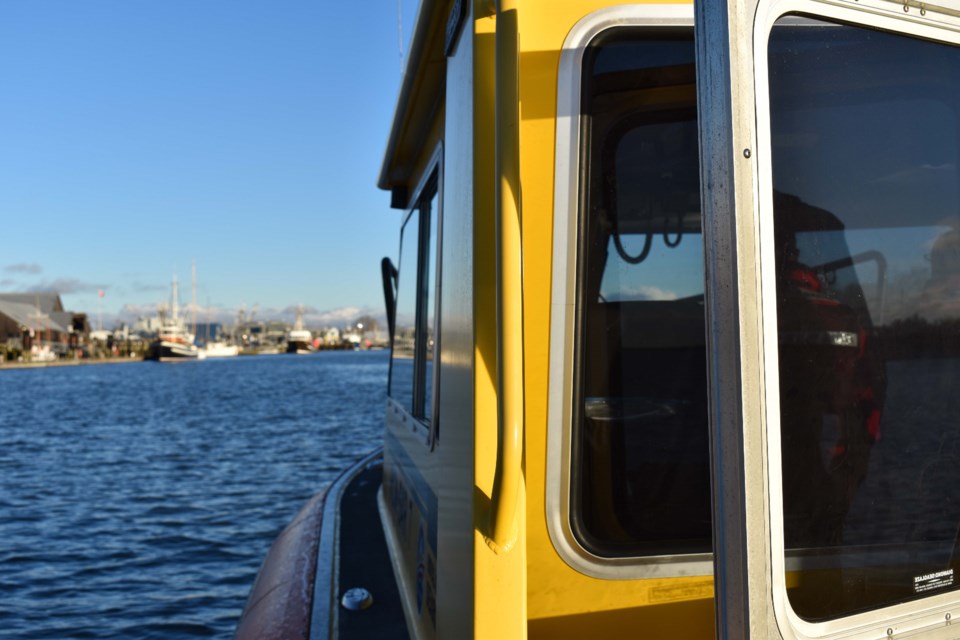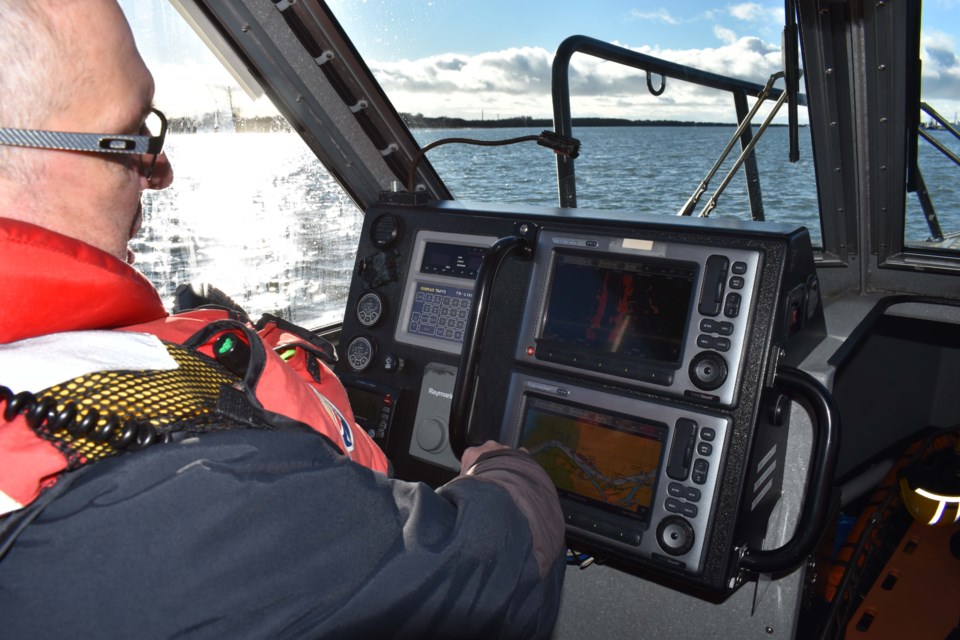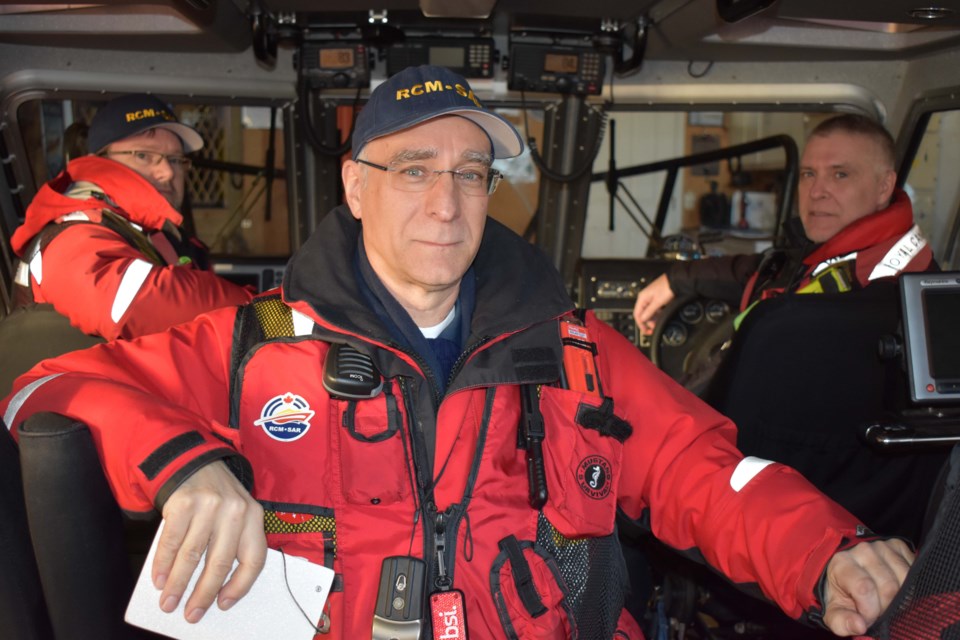“Have you heard of the 1-10-1 principle? It’s the three survival phases of sudden immersion in cold water.”
My initial amusement at RCMSAR coxswain Mike Janicki’s opening question, as I walked into their Steveston Harbour boathouse, grew into moderate concern.
After all, I had planned on spending most, if not all, of my ride-along with the volunteer rescue service on the boat.
Apparently, 1-10-1 refers to the first minute after accidentally falling into cold water, where you have to keep your head above water as the temperature shock will make you gasp; then 10 minutes to rescue yourself before you lose muscle control; and lastly, you have one hour before you lose consciousness from hypothermia.
So rule #1 for Alan: Stay in the boat.
All joking aside, it was all about safety for Janicki and his crew for the day, driver Aaron Harnden, navigator Dave Ralston and crew member Ben Clark.
No stone was left unturned in the preparation for the brief voyage out from Steveston Harbour, up the south arm of the Fraser River and around the islands north-west of Ladner.
Lifejackets were on and a complete rundown of all my attached safety devices was delivered.
And, as we reversed slowly out of our harbour berth, I was comforted to hear our 33-foot vessel – complete with twin V6 (300 horsepower engines) – was a rigid-hulled inflatable (RIB) which is “virtually impossible to sink,” according to Janicki.
This was especially good to hear, given how much talk we’d had about how to stay alive in freezing water.
As we motored out into the harbour itself, sailing past a dredger hard at work, Janicki radioed to the authorities to let them know we were out.
At any point in time, our vessel could be tasked to assist the coast guard in a marine rescue, which is RCMSAR (Royal Canadian Marine Search and Rescue) Station 10’s primary purpose.
The station’s operational responsibilities extend as far south as Point Roberts, as far north as Bowen Island, west to the Gulf Islands and east, up the Fraser River to Pitt Lake.
They are tasked with all manner of situations, such as broken down boats, sinking boats, overdue boats, kayakers, and to help with searches for people, including bridge-jumpers.
The 48-strong team, all volunteers, which has launches at Steveston Harbour and on the Fraser River’s middle arm, raced to more than 40 missions last year and completed 93 the previous year.
Sailing past the dock at Imperial Landing, Ralston was busy on the electronic charts and radar, checking the traffic ahead for when we come out of the harbour, so we know what the picture looks like when we enter the south arm.

The vessel, the B.R. Hastings, is armed with a $10,000 high-res radar – donated by ANAF in Steveston – and a $15,000 infra-red camera, gifted by G&F Financial in Richmond.
As we cruised through the harbour, Janicki pointed out the main dangers in this stretch: pleasure boats, kayaks, paddle boarders, boats coming out from their docks and people on the docks. “We gotta make sure our wake doesn’t knock them off.”
Out of the harbour, Harnden opened up the engines a little and we began skipping across the waves, heading up the south arm of the Fraser.
Actually, “skipping” was Harnden’s description. To me, it felt like we were thumping into every single wave, as we fought the tide and current and I gripped onto one of the safety bars in the cabin.
“This is not too bad for this time of year,” quipped Janicki, chuckling at my white knuckles.
What Harnden was doing was accelerating off and on, in an attempt to pick a path over the waves, hence the need in the cabin for shock-absorbing seats.
“We have to get to an incident before we can affect it. By smoothing out the ride, we conserve as much energy as possible to then be able to deal with whatever situation presents itself,” Harnden shouted over the roar of the engines and the “skipping.”
“There was one time we got called out to a sailing boat, which had lost contact, one person was on board out in the Strait of Georgia.
“It was blowing 40 knots, at 2 a.m. We took it across to a safe bay, the crew had a rest, then we had to come all the way back, 90 minutes in 10 to 12-foot waves…in the dark.
“What’s interesting about this area (Fraser River), is the waves can be closer together. You throw the current in there and it’s difficult to judge.”

Just before the Massey Tunnel, we turned south toward Ladner, past Kirkland, Gunn and then Barber islands, before heading northwest past Westham Island.
In the calmer inlets, I took over at the wheel for a short time and, although they understandably didn’t let me open her up, I could feel the power of the twin V6 engines at my disposal.
Asked what scares him the most while behind the wheel, Harnden said logs, especially lots of them.
“At night, you can’t see those logs and we feel the thumps and thuds,” he said.
“One log is not so scary; what is scary is a bundle of them. They do come up on the radar, if they’re showing about four to six inches above the water.
“But if the boat goes up on a wave, the radar goes up, so the timing of the boat going up and down will affect your ability to pick up the logs on the radar.”
The radar, explained Harnden, spins at 48 revolutions per minute.
“The cheaper ones spin at half that rate. So if you’re trying to get a good picture of what’s out there, you need this.
“We need to have the confidence to know what’s out there before we can really speed up and get to situations we are tasked with.
“And in the river here at night, there are sometimes little fishing pugs out here that perhaps shouldn’t be. We could run them over if we didn’t have the right radar.”
Before coming out of the island inlets, we plotted a safe route across the river, back to Steveston Harbour.
Back in the safe haven of the harbour, we cruised past Pajo’s fish and chips dock, where Janicki recalled RCMSAR being one of the first on the scene when their ramp collapsed in July 2017.
“There was lots of close quarters manoeuvering to get people safe.”
After “parking” in the boathouse, it was time to step back on dry land…without ever having to put into practice the 1-10-1.
If you would like more information on volunteering with, or donating to, RCMSAR, go online to RCMSAR10.org.



